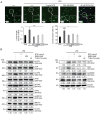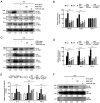Understanding the role of iron/heme metabolism in the anti‑inflammatory effects of natural sulfur molecules against lipopolysaccharide‑induced inflammation
- PMID: 40280116
- PMCID: PMC12046942
- DOI: 10.3892/mmr.2025.13542
Understanding the role of iron/heme metabolism in the anti‑inflammatory effects of natural sulfur molecules against lipopolysaccharide‑induced inflammation
Abstract
Iron transport and heme synthesis are essential processes in human metabolism, and any dysregulation in these mechanisms, such as inflammation, can have deleterious effects. Lipopolysaccharide (LPS)‑induced inflammatory responses can result in a number of adverse effects, including cancer. Natural mineral sulfur, methylsulfonylmethane (MSM) and nontoxic sulfur (NTS) suppress inflammatory responses. The present study hypothesized that MSM and NTS may inhibit LPS‑induced inflammatory responses in THP‑1 human monocytes. Reverse transcription‑quantitative PCR and western blotting assays were performed to analyze the molecular signaling pathways associated with sulfur‑treated and untreated cells. A comet assay was used to evaluate DNA damage, flow cytometry was performed to analyze cell surface receptors and chromatin immunoprecipitation was used to examine molecular interactions. Notably, LPS‑induced inflammation increased iron/heme metabolism, whereas MSM and NTS inhibited this effect. Furthermore, LPS treatment activated the Toll‑like receptor 4/NF‑κB signaling axis, which was downregulated by NTS and MSM. These sulfur compounds also suppressed the nuclear accumulation of LPS‑induced NF‑κB, which could induce the production of proinflammatory cytokines, such as TNF‑α, IL‑1β and IL‑6. Finally, MSM and NTS inhibited LPS‑induced reactive oxygen species generation and DNA damage in THP‑1 monocytic leukemia cells. These results suggested that natural sulfur molecules may be considered promising candidates for anti‑inflammation studies.
Keywords: anti‑inflammation; iron/heme metabolism; lipopolysaccharide; natural sulfur; oxidative stress.
Conflict of interest statement
The authors declare that they have no competing interests.
Figures







Similar articles
-
Sulfur Compounds Inhibit High Glucose-Induced Inflammation by Regulating NF-κB Signaling in Human Monocytes.Molecules. 2020 May 17;25(10):2342. doi: 10.3390/molecules25102342. Molecules. 2020. PMID: 32429534 Free PMC article.
-
Non-toxic sulfur inhibits LPS-induced inflammation by regulating TLR-4 and JAK2/STAT3 through IL-6 signaling.Mol Med Rep. 2021 Jul;24(1):485. doi: 10.3892/mmr.2021.12124. Epub 2021 Apr 28. Mol Med Rep. 2021. PMID: 33907855 Free PMC article.
-
New Insights into the Pivotal Role of Iron/Heme Metabolism in TLR4/NF-κB Signaling-Mediated Inflammatory Responses in Human Monocytes.Cells. 2021 Sep 27;10(10):2549. doi: 10.3390/cells10102549. Cells. 2021. PMID: 34685529 Free PMC article.
-
Bombyx mori hemocyte extract has anti-inflammatory effects on human phorbol myristate acetate-differentiated THP‑1 cells via TLR4-mediated suppression of the NF-κB signaling pathway.Mol Med Rep. 2017 Oct;16(4):4001-4007. doi: 10.3892/mmr.2017.7087. Epub 2017 Jul 26. Mol Med Rep. 2017. PMID: 28765923 Free PMC article.
-
Natural Sulfurs Inhibit LPS-Induced Inflammatory Responses through NF-κB Signaling in CCD-986Sk Skin Fibroblasts.Life (Basel). 2021 May 10;11(5):427. doi: 10.3390/life11050427. Life (Basel). 2021. PMID: 34068523 Free PMC article.
References
-
- Alam Z, Devalaraja S, Li M, To TKJ, Folkert IW, Mitchell-Velasquez E, Dang MT, Young P, Wilbur CJ, Silverman MA, et al. Counter regulation of spic by NF-kappaB and STAT signaling controls inflammation and iron metabolism in macrophages. Cell Rep. 2020;31:107825. doi: 10.1016/j.celrep.2020.107825. - DOI - PMC - PubMed
MeSH terms
Substances
LinkOut - more resources
Full Text Sources
Medical

